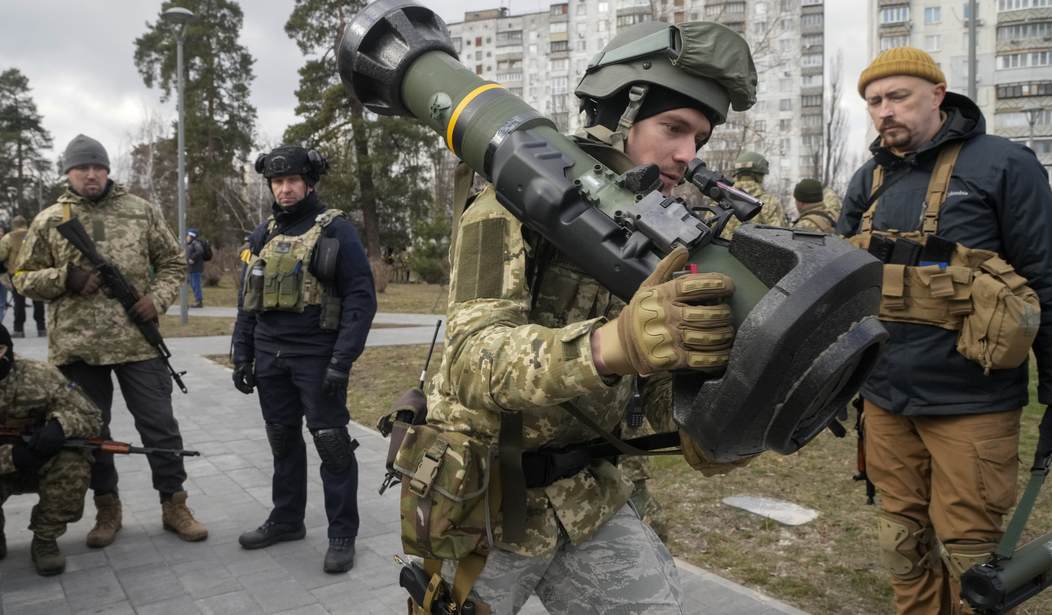Ukraine got some welcome news on Sunday when the British government announced it would send arguably the best Man Portable Air Defense System (and you thought MANPADS was something to do with transsexuals, didn’t you?)
The weapon system might be the solution needed to keep Russian fixed and rotary winged aircraft out of the battlespace.
British -made anti-aircraft missiles are about to be deployed by Ukraine in the conflict for the first time, threatening to heap further humiliation on Vladimir Putin over his disastrous invasion.
Defence Secretary Ben Wallace told The Mail on Sunday that the Starstreak system – a shoulder-mounted missile that travels at more than three times the speed of sound to take down low-flying enemy jets – was ready to be used imminently.
(Watch the video to savor the narrator’s accent, if nothing else).
The US is also offering up some state-of-the-art equipment.
As part of a massive military aid package announced Wednesday, the Biden administration is providing Ukraine with U.S.-made killer drones — cutting-edge guided missiles that could accurately target Russian troops from miles away — two congressional officials briefed on the matter told NBC News.
The White House referred to the weapons in a fact sheet on the aid package as “100 Tactical Unmanned Aerial Systems.” NBC News reported exclusively Tuesday that this move was under consideration.
There are two variants of the weapon, the Switchblade 300 and the 600, that have been sold to U.S. Special Operations Command by manufacturer AeroVironment, based in the suburbs of Washington, D.C. The 300 is designed for pinpoint strikes on personnel, and the larger 600 is meant to destroy tanks and other armored vehicles. The Congressional officials did not have clarity on which variant would be provided to Ukraine, or whether both would be.
Both of these weapons will be welcome additions to the Ukrainian Army. Starstreak will make life Hobbesian (“solitary, poor, nasty, brutish, and short”) for aircraft flying below about 15,000 feet. Switchblade will play havoc on Russian resupply routes and artillery positions. As the war enters a new phase, the question is not what weapons NATO is willing to give to Ukraine, but the weapons it is not willing to give and why that may be.
Today saw a significant pullback by Russian forces all along the northern front. As US “officials” are so fond of saying, these units are not withdrawing; they are repositioning. All the big brain thinkers in DC are investing in the narrative that Russia will make a huge push in Donbas and sue for peace, attempting to hold onto his gains. Or that he will use the Donbas as a diversion to pull Ukrainian forces there, then make another run at Kiev. Regardless of what Putin decides to do, I think the next couple of weeks will shape up a lot like this.
Putin has used about 75% of the Russian Army’s maneuver units in this campaign. They have been mauled. This is not to say they haven’t dealt damage themselves to the Ukrainian Army as well as the casual damage to cities and the killing of civilians, only that vehicle and personnel losses are pushing those units into combat ineffectiveness. The units now withdrawing into Russia and Belarus will spend most of the next two weeks receiving replacement equipment and integrating new soldiers into the unit. The new soldiers might be veterans of the war but members of units that are so depleted that they have been broken up rather than rebuilt, or they might be some of the 100,000 reservists Putin has ordered to active duty (see Russia Calling 100,000 Reservists to Active Duty and Moving Wagner Group From Syria to Deal With Ukraine Manpower Crunch). After rebuilding, they will be shifted laterally, almost certainly by rail, to Donbas. With the rebuilt units, Donbas draftees (Putin’s fake republics have increased their maximum age of conscription to 65), and new units pulled in from other parts of Russia, a new offensive will kick-off. Its objective will be to expand the territory of Donetsk and Luhansk and establish a land bridge to Crimea.
Ukraine will have two weeks to catch its breath and decide how to meet the challenge. Part of the challenge will be training the army that Ukraine needs to win the second phase of the war and win it decisively.
In my judgment, the Ukrainian military needs Surface-to-Air Missile (SAM) systems that can reach into Belarus and neutralize the ability of Russia to stage attacks from that country as well as dominate their own skies. It needs replacement tanks and infantry fighting vehicles to allow the Ukrainian Army to create the mobility and shock effect for decisive action. They need anti-ship missiles to make life more interesting for the Russian Navy. They also need those famous MiG-29s so the Ukrainian Air Force, in concert with SAMs, can create the condition of air superiority, if not outright air supremacy. Our NATO allies, who were formerly part of the Warsaw Pact, have SAMs, tanks, and aircraft that are largely familiar to Ukrainian troops and can be brought into action before Russia can kick off its Phase II offensive.
If you look carefully at the weapons we’ve sent to Ukraine so far; they’ve been totally defensive. But you can’t win a war based on defense alone. Defense is only not a precursor to total defeat when it is being used to set up an offensive maneuver. With Javelin, Starstreak, Switchblade, etc., all Ukraine can ever do is hold its own and wait for Russia to lose interest. Day by day, the Ukrainian Army becomes more and more foot-bound or dependent upon commandeered civilian vehicles.
More than two weeks have passed since Defense Secretary Lloyd Austin traveled to NATO ally Slovakia, where he discussed transferring that country’s most advanced air defense system to Ukraine. But as Russian missiles continue to rain down on Ukrainian hospitals, schools and apartment buildings, there’s no visible progress. As a result, Congress is losing patience and Ukrainians are losing their lives.
Standing next to Austin in Bratislava on March 17, Slovakian Defense Minister Jaroslav Nad’ said his country was ready to transfer the Russian-made S-300 missile defense system, which the Ukrainians know how to operate, “immediately.” Compared to what Ukrainian forces have now, the S-300 could cover more ground and intercept more advanced incoming aircraft and missiles, potentially saving a lot of civilians. Nad’s one condition was that the United States should replace Slovakia’s S-300 with another missile defense system at least as capable. Austin made no firm commitments, other than to continue discussions with NATO partners.
Two weeks later, U.S. lawmakers and Ukrainians are wondering why there’s no movement. The other two NATO countries that have S-300 systems, Bulgaria and Greece, have been cool to the idea of sending direct military assistance on Ukraine. Slovakia is ready to go. So, what’s the holdup?
…
“The transfer of any system is being closely scrutinized by the White House and National Security Council as to whether or not it meets their test of what’s escalatory and what’s not,” a senior congressional aide told me. “That’s causing the system to be constipated.”
This “afraid to make Putin mad” impulse in a White House that is bracing itself for what is on Hunter Biden’s laptop and the compromising material that is undoubtedly in possession of Putin’s FSB is what Jack Keane was discussing on Fox News recently.
Bottom line. The war is entering a new phase. The initial Russian attack has burned itself out (Russia’s Invasion of Ukraine Reaches Its Culmination Point and Zelensky Plays Hardball in the Peace Negotiations). The units that led the offensive are combat ineffective and are being pulled out of the line to reconstitute in safe areas. At the same time, Ukraine is building units and absorbing “home guard” outfits raised by Zelensky’s call for levee en masse. I estimate that this next phase will last about two weeks. During that period, Ukraine needs to try to reshape its army from one based on Territorial Defense Forces to one with the striking capability for decisive action. It also needs air defense to clear its skies of Russian aircraft and drones. If NATO is not forthcoming with the needed weapons systems, this war will go to a stalemate. That is not something we should want to see.














Join the conversation as a VIP Member